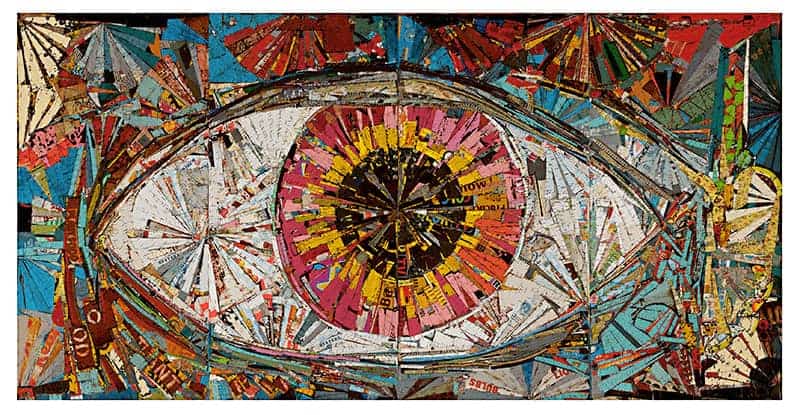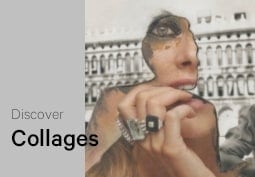Articles and features
5 Contemporary Collage Artists Adding New Layers
By Shira Wolfe
“Collage is the cut, the tear, the rupture and the overlay of our contemporary culture. It is the hybrid language of urbanity—remixed, re-contextualized, and wholly built from the fragments of daily life.”
Pavel Zoubok
The first examples of collage art were made over 100 years ago, when Georges Braque and Pablo Picasso, at the height of their artistic exchanges, burst into completely new territory with their avant-garde papiers collés. Cutting, ripping, pasting, overlaying different textures and materials, the two artists started examining and dissecting objects and life in a radically new way. Since then, collage artists from countless different movements, from Surrealism to Abstract Expressionism and Pop Art, have been exploring the technique. Contemporary artists continue to work with the medium in ways that offer us new notions of what it can be and how it reflects on the world around us. In a conversation with collage specialist Pavel Zoubok, we reflected on the common misconceptions that have been following collage art around for a long time.
For one, collage is often considered as intimate, scaled work. Yet take an artist like Mark Bradford: he defies this notion with his impressive, large-scale works combining standard paints and collage. This brings us to the second common misconception, that collage never encompasses painting. Collage artists like Bradford show us this is not the case, as well as David Salle, whose painting in the ‘80s was absolutely guided by a “collage-type-thinking” inspired by film montage. Finally, people often consider collage to be lesser than other art forms, viewing it as a second cousin to painting and sculpting. Rather than considering collage as a pure art form in and of itself, people tend to see it as a step on the way to something else. This strange understanding of collage is easily dismantled when taking a look at the rich, creative and ground-breaking history of collage. American Pop Artist James Rosenquist, for example, started out by making collages which were studies for his large-scale paintings. Yet the collages started taking on a life of their own, and Rosenquist eventually presented them as powerful standalone artworks.
“I am interested in preserving the memory of the first, ‘raw version’ of an event, before the process of memory takes over and reshapes, even deforms the actual event over the years.”
Laslo Antal
Famous Collage Artists Reinventing the Medium
The following collage artists, each in their own way, challenge and dismantle the narrow-minded notions about collage. They show us how powerful, inspiring and relevant the art of collage still is today and continuously explore how they can redefine and reinvent the medium.
1. Laslo Antal – Visual Diaries
The first of our selection of collage artists, Laslo Antal is a Hungarian artist from Serbia who is based in Berlin. The focus of his artistic practice lies with the collage medium. In 2017, he started the daily art project “Visual Diaries.” Every day, Antal makes one collage, narrating a single event in that day. This results in an incredibly diverse range of topics and themes, at times revealing the artist’s most intimate and emotional moments, at other times presenting seemingly banal situations or bizarre everyday experiences. Moments of shame, pain, frustration or utter simplicity are depicted just as often as moments of beauty and success in the artist’s everyday life.
In his collage Pain Thing (2019), the artist depicts himself in agony – three heads and three oesophagi lead down into a stomach that is burning bright red. In Love – so many times explaining the same same thing (2018), we see a portrait of a screaming man, the top of his head opening up to reveal red smoke escaping. Beneath the portrait, the artist has scrawled the words: “You used to drive me crazy, but now I don’t feel anything.” Loss and death are also processed through the collages. In A ritual in the cemetery, to let things go (2018), we see Antal in the middle of a deeply personal moment, scattering what might be flower petals, snow, or soil over the grave of a man. He becomes even more direct in My 70 year old D(e)ad (2018), dedicated to his father who passed away. On other days, he might choose to reflect on a simple night catching up with friends, like in Still a Saturday Still (2019). Each event finds its place in Antal’s collages.
The project aims to raise questions about what happens to intimacy once it enters the public sphere, about the unreliability and fickleness of memory, and about the role of the artist as a witness to and recorder of the world around us. As Antal himself explains, “I am interested in preserving the memory of the first, ‘raw version’ of an event, before the process of memory takes over and reshapes, even deforms the actual event over the years. While some people need a lot of time to pass in order to process and understand life events, I need this immediate form of processing or I feel I lose touch with those experiences. The person I was a year ago, or two years ago, has in many ways changed so much to become the person I am today. If I don’t record my immediate experiences every day, I’m afraid I might never be able to access those parts of myself again.”
Influences and Style
Visually, the artist cites Henry Moore’s monumental sculptures, Jenö Barcsay’s mosaic work, and Marc Chagall’s painting among his many inspirations. Indeed, Antal’s distinctive hands are reminiscent of the large, rough, monolithic hands of Moore’s figures. Elsewhere, the bulky yet sensual figures from Barcsay’s mosaics seem to shine through in Antal’s colourful, dynamic figures.
Rather than using newspapers, photographs, or other pre-made images and materials like in more conventional collage-work, Antal almost strictly works with his own drawings and prints. Using a personal technique he developed over the years, he imprints sheets of paper with oil and acrylic paint. He then cuts, rips, and pastes these, adding his own drawing and painting and often including written words or sentences.
Flux and Grounding
Antal’s collages reveal a unique perspective on all the little scattered moments that make up human life. A prolific visual storyteller, each moment becomes important – from lonely nights in the city to exhilarating travels and deep connections. “As a Hungarian who grew up in Serbia in the ‘80s and ‘90s and moved to Berlin I have often felt out of place and hovering in-between worlds, so it is important for me to make these connections between the places where I live, have lived, and travel,” says Antal. “Wherever I go, I bring with me my 28cm x 35cm workbook and my materials, so that I can end every day with the practice of making my daily collage. The daily collage then becomes a kind of grounding practice for me, a ritual of home, wherever I am.”
For more information about Laslo Antal, see:
Laslo Antal Website
Laslo Antal Instagram
Novembar Gallery
“I started doing collages because they were quick and I could work through ideas quickly. In an unexpected way it developed into a voice that continues today.”
Lance Letscher
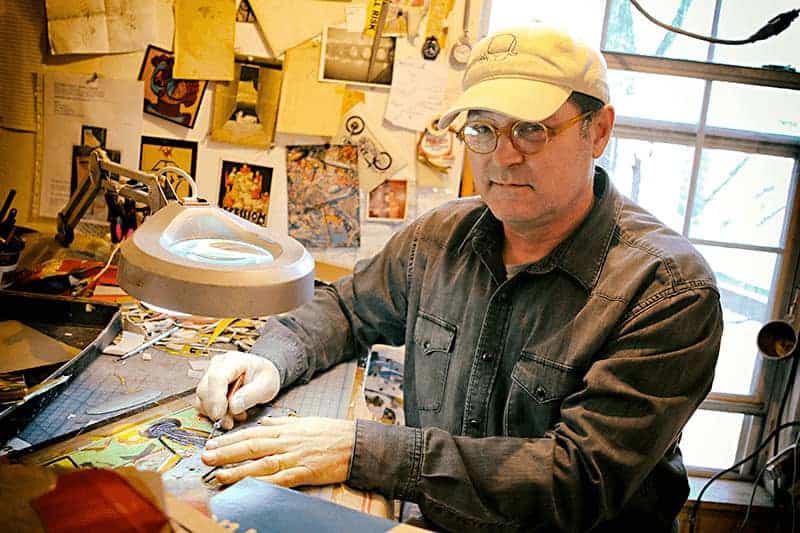
2. Lance Letscher – The Pull Towards Collage
We continue our overview of collage artists with Lance Letscher. Based in Austin, Texas, his work speaks to the idea of collage as a quasi-narrative way of working. Letscher started out with drawing and painting, before turning to collage and assemblage full-time in the early 2000s. In an interview, he explains: “I started doing collages because they were quick and I could work through ideas quickly. It’s always been an emphasis in my life to draw. I would use drawing to work myself out of problems. It just blossomed from there. In an unexpected way, it developed into a voice that continues today.”
Letscher often finds materials in dumpsters, half-price books, and other discarded objects. He is usually most attracted by the things that people throw away, carrying marks, grime, and signs of wear and tear. He tends to gather his material in piles according to colour or other markers. Then, he starts cutting pieces and assembling the different parts, gluing, pressing, and recutting the different parts to create their finished shape. Usually, Letscher assembles his different parts without glue first, trying out different compositions until he is satisfied. This can be a long and laborious process. When he’s happy with the composition, he transfers the parts onto a board and glues them. Due to the scale of his work, the drying time can be around three days. And even then, the artist often decides to alter the works – he might end up cropping or cutting parts of the collage after it has dried and can really see what the finished work looks like.
Trauma and Memory
Memory plays a big role in Letscher’s collages, as well as dealing with his personal psychological traumas. After the suicide of his father in 2010, Letscher explains that his work changed dramatically and become a lot more expressionistic, dealing more with psychiatric issues. At the same time, once Letscher begins an artwork, even though he may start out with a story that continues to develop, the materials he works with are the main actors driving the work. For Letscher, collage provides a language with which to navigate the chaos of life and to find structure, beauty, and peace. For as chaotic as his collages may seem, there is a serenity to be found there – like in the many hands encapsulated in blue geometric shapes reaching out to each other, hovering above a rowboat bouncing on the waves in Row Boat (2018).
The project aims to raise questions about what happens to intimacy once it enters the public sphere, about the unreliability and fickleness of memory, and about the role of the artist as a witness to and recorder of the world around us. As Antal himself explains, “I am interested in preserving the memory of the first, ‘raw version’ of an event, before the process of memory takes over and reshapes, even deforms the actual event over the years. While some people need a lot of time to pass in order to process and understand life events, I need this immediate form of processing or I feel I lose touch with those experiences. The person I was a year ago, or two years ago, has in many ways changed so much to become the person I am today. If I don’t record my immediate experiences every day, I’m afraid I might never be able to access those parts of myself again.”
The Secret Life of Lance Letscher
In recent years, Letscher started working with metal as material for his collages. While working on a public art project in Austin, Texas, for which he created the large mural Big Eye (2015) out of scrap metal, director Sandra Odair filmed his working process, resulting in the documentary The Secret Life of Lance Letscher. From the same period is Letscher’s metal collage Hand (2016), a massive assemblage of cobalt blue and copper metal scraps from India. Letscher’s Black Bird from 2017 is another arresting metal collage. The seemingly sweet imagery of a blackbird with flowers on its feathers is juxtaposed with the harsh reality of the metal material and the staples aggressively covering the work.
“I’m really into color and space and the illusion of space,” explains Letscher. “I enjoy using formal elements to play tricks and to guide the eye through the piece.”
For more about Lance Letscher, see:
Lance Letscher Website
Lance Letscher Documentary
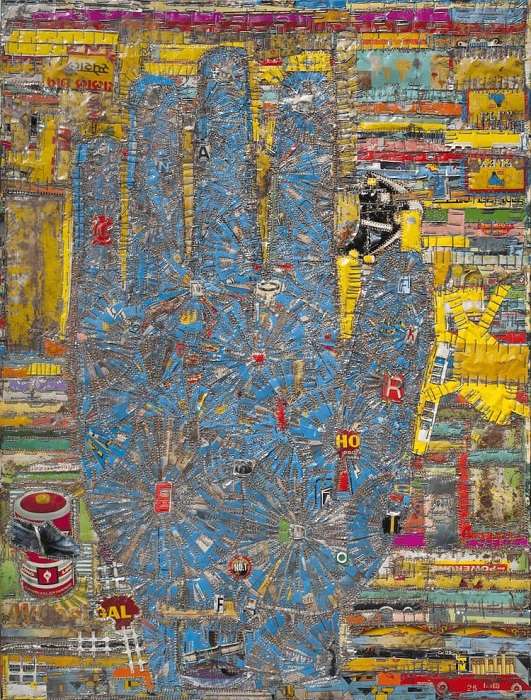

“For me, a big part of this work is about technique. It’s about figuring out how to manipulate your materials in such a way that it can get really thick and layered and contain the colours.”
Raquel van Haver
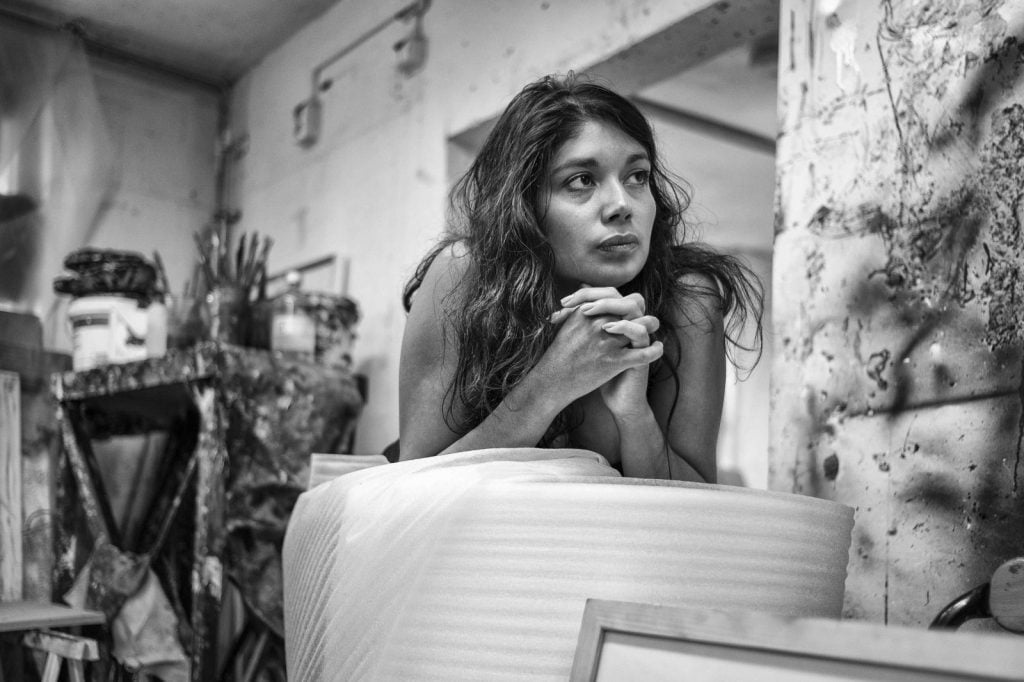
3. Raquel van Haver – The Collage Mindset
Spending time with the large-scale, layered paintings by Colombian-born Dutch artist Raquel van Haver, it quickly becomes clear that there is something of a collage mindset at play here. Van Haver started exploring her by now signature style, employing thick layers of paint and often adding found objects and different materials, back when she was in the art academy in Utrecht. Over the years she started investigating more and more how far she could take it. “For me, a big part of this work is about technique. It’s about figuring out how to manipulate your materials in such a way that it can get really thick and layered and contain the colours,” explains Van Haver.
Van Haver starts with drawing on the canvas, then works with a thick-to-thin approach. First she’ll paint a thick layer, next a thin one, and so forth. The objects she adds to her canvases often contain some symbolic meaning for the artist. Anything from cigarette butts to fake hair, drumsticks, mobile phones, bead eyes, and Nollywood posters have ended up in her paintings.
Themes
Van Haver’s work explores people from all walks of life and all layers of society across the world. She is particularly passionate about showing glimpses of people’s lives who might usually be overlooked in society, or pushed to the side – people who live on the fringes, people who are stigmatised and marginalised. As such, she’s spent time cultivating relationships with young men hanging out on the streets of her neighbourhood in Amsterdam Southeast and in London, with gangs of teenagers in Lagos, Nigeria, and with people in the ‘favelas’ of South America. She gets to know people, in a sense starts living with them, and then starts taking their photographs. These photographs, she later uses as studies for her paintings, where she weaves together different faces and places to create assemblage-type works of the people she’s met on her travels and in her daily life.
For more on Raquel van Haver, see:
Jack Bell Gallery
Stedelijk Museum Amsterdam
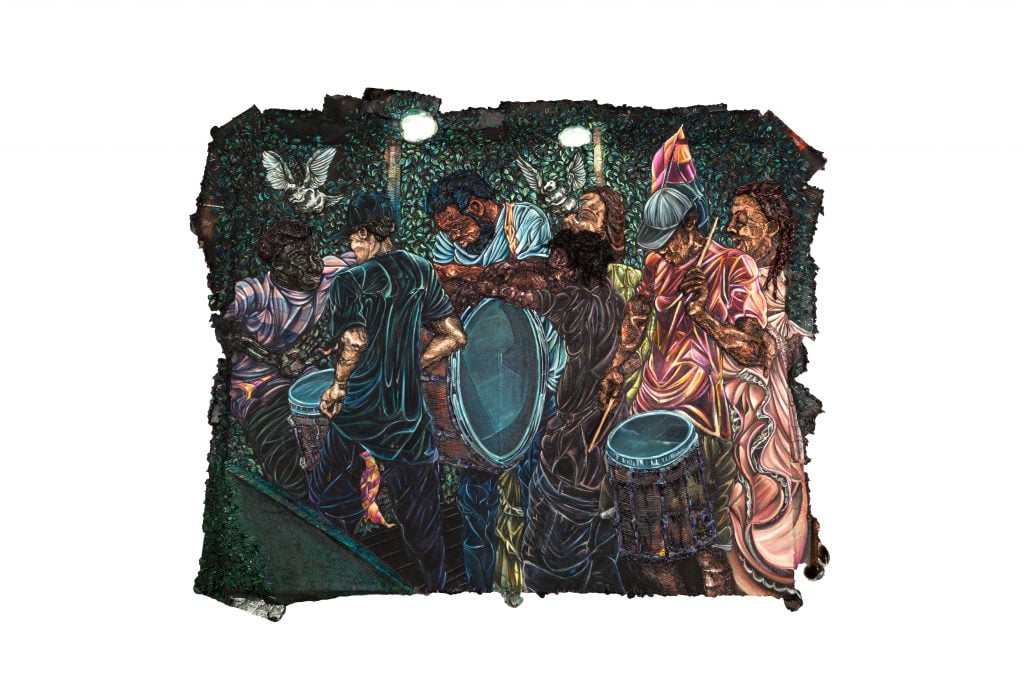
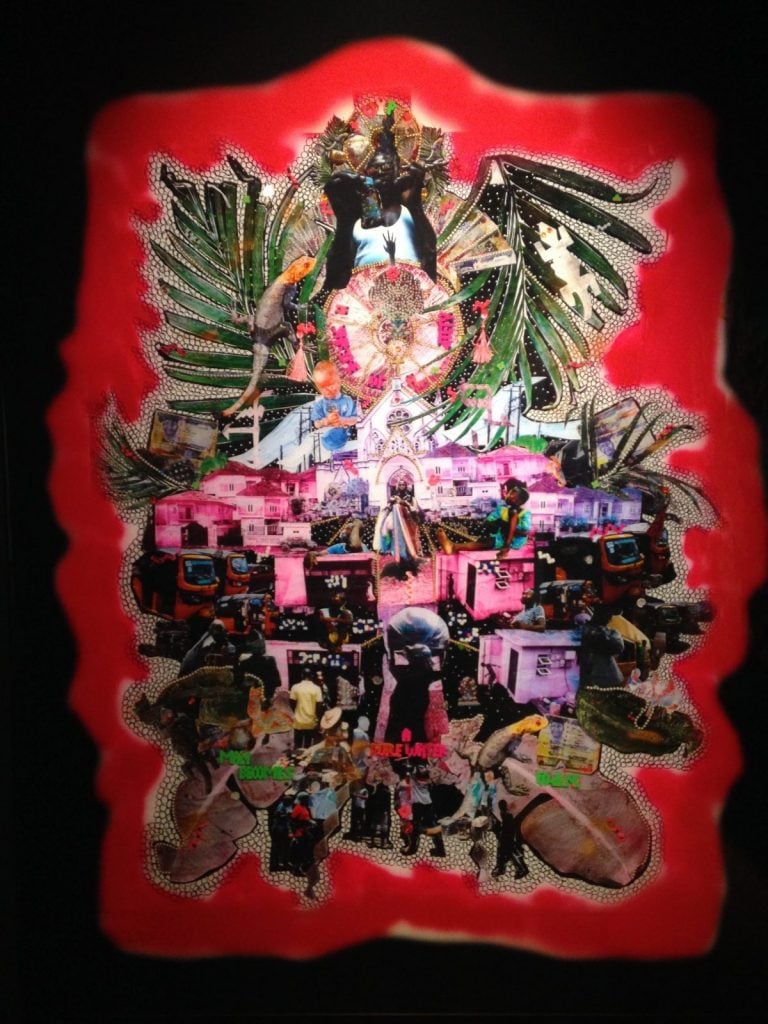


“A shard of glass looks worthless. But when you put those shards together you can create an entirely new picture.”
Vanessa German
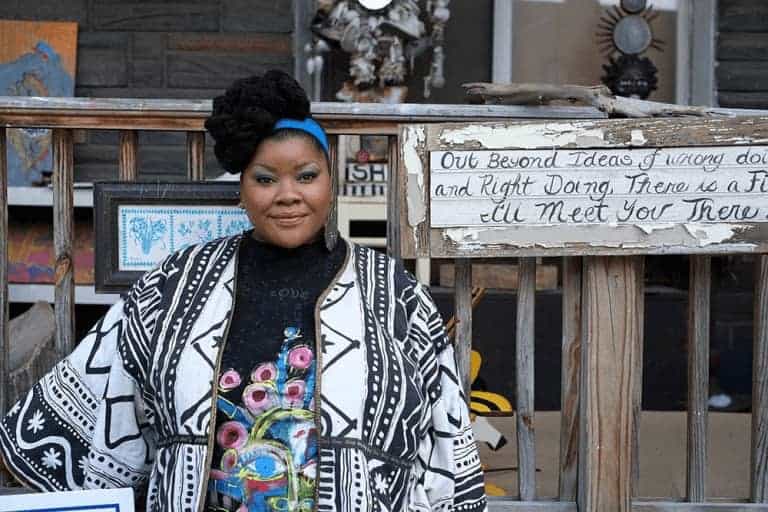
4. Vanessa German – From Found Objects Towards Assemblage
Pittsburgh-based artist Vanessa German grew up in LA in the ‘80s and ‘90s, where her mother, who was a quilter, taught her at an early age to create her own worlds through artistic expression. During a particularly difficult period in her adult life, German started collecting objects she found on the streets of Pittsburgh while walking her dog. She would take the objects, ranging from glass to cans, buttons, fabric, bottles, and scraps of paper, to her basement and start assembling them into works of art. Speaking to Harold C. Ford of East Village Magazine, German notes: “A shard of glass looks worthless. But when you put those shards together you can create an entirely new picture.”
A perfect example of how contemporary collage artists are reinventing the medium, German’s mixed-media assemblage practice fluctuates between the layering of different materials on large boards and a real three-dimensional, sculptural exploration of assemblage. These are the works that she is perhaps most known for – her powerful female bodies bulging with found objects and symbolic elements. They are power figures akin to the Central African tradition of nkisi, composed of empowered objects (shells, bottles, keys, fabric pouches, string, beads, rhinestones, etc.) and are meant to heal, protect, and ward off evil.
Miracles and Glory Abound
An exhibition at the Flint Institute of Arts (which ran through 20 April 2019) presented as the centrepiece a mixed-media installation entitled Miracles and Glory Abound (2018). This impressive sculptural assemblage is a life-sized representation of Washington Crossing the Delaware (1851), the iconic painting by Emanuel Leutze. Leutze’s art is one representation of a foundational story about the birth of America, depicting George Washington leading Continental soldiers across the Delaware River in 1776. German’s piece directly challenges Leutze’s narrative and asks her viewers to consider who are the actors that get to decide on and shape history. Miracles and Glory Abound is a boat filled with human figures, all of whom are African American. As noted by Holly Bass, a writer, and performance artist, “She (German) inserts and asserts her Blackness, her womanness, her multivalent queerness, into this ongoing American narrative and asks us to consider the birth of this nation, a mythology of chopped cherry trees and founding fathers lying through wooden teeth.” German’s elaborately embellished assemblage-works call for communal transformation, healing through art, and a reassessment of grand narratives.
For more information about Vanessa Germans, see:
Vanessa German Instagram

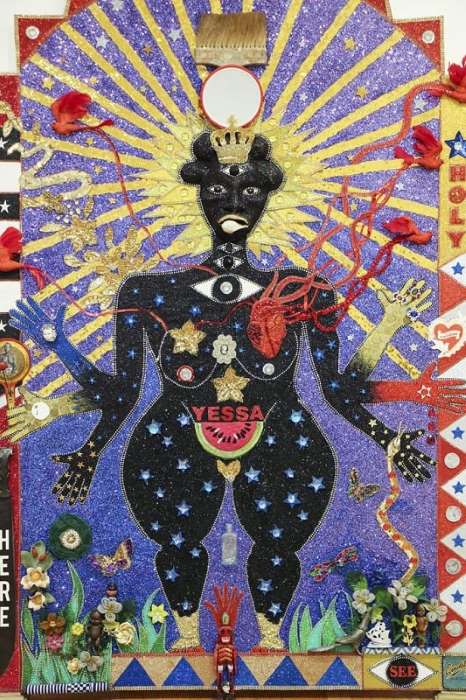
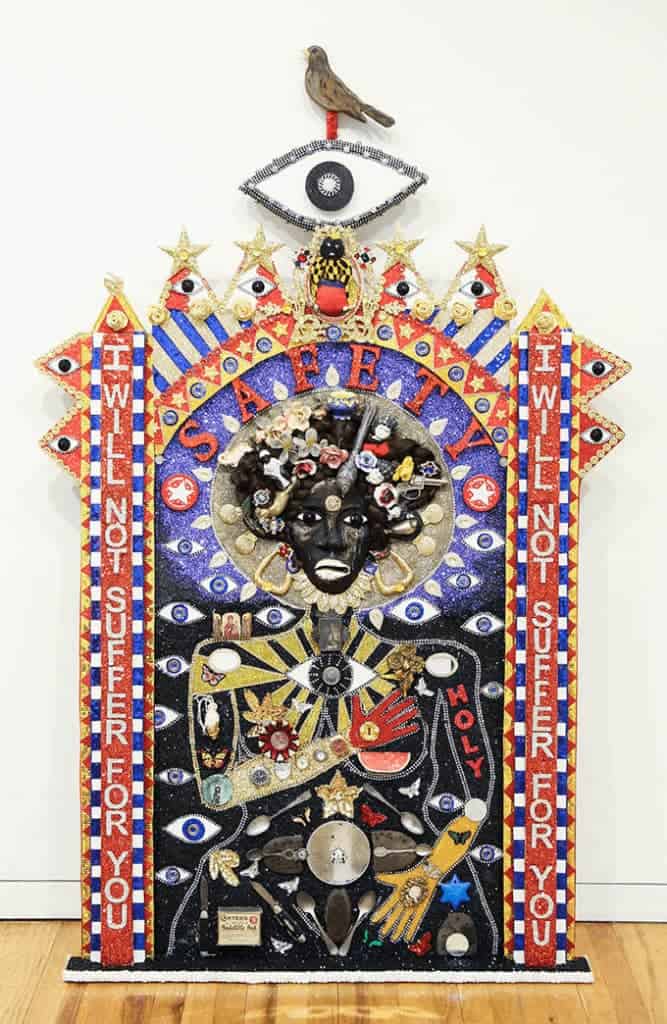
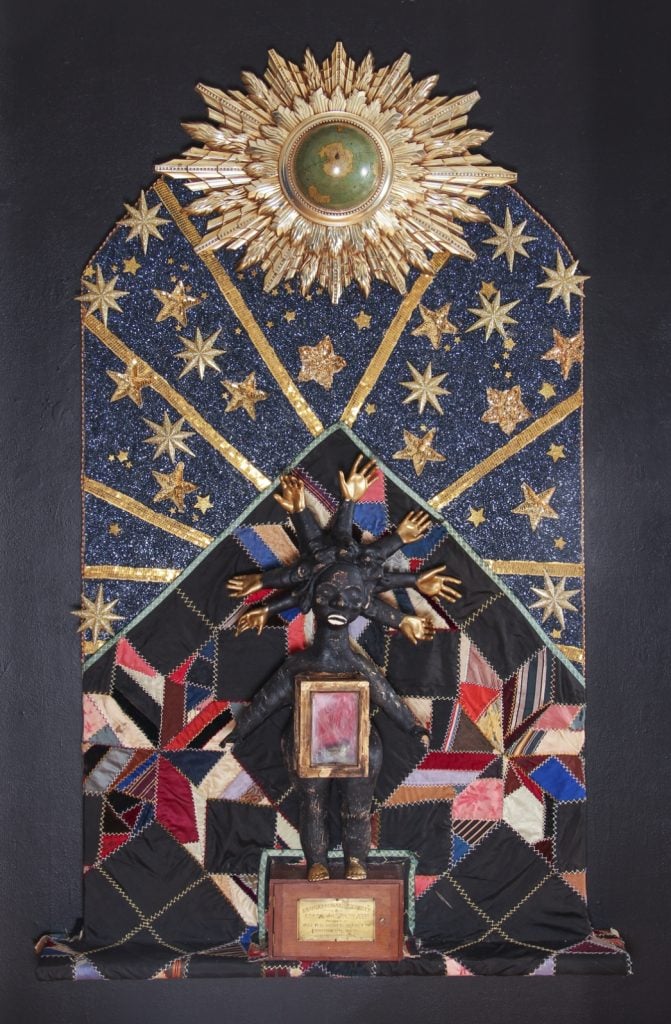
“To make things make sense, I have to make things up.”
Wangechi Mutu
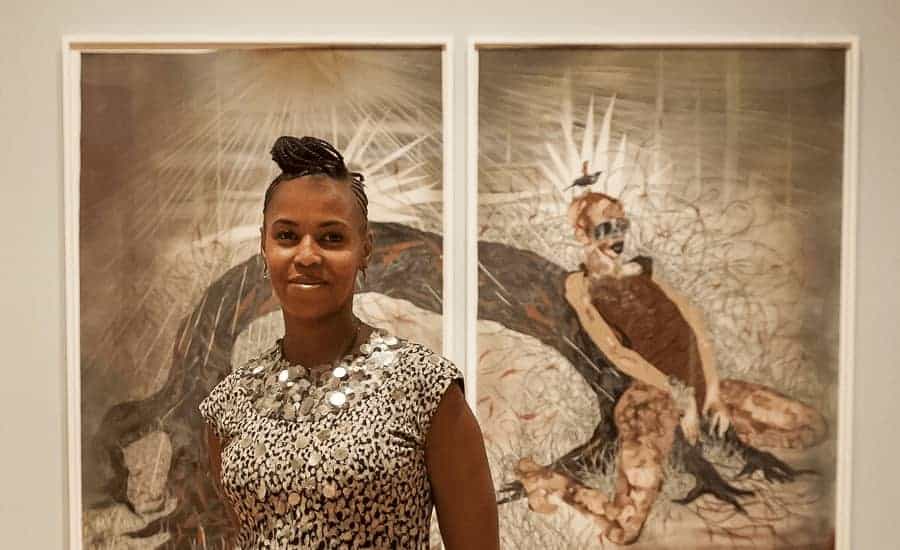
5. Wangechi Mutu – Female Motives
The last of this series of cutting-edge collage artists, Wangechi Mutu is a Kenyan artist based in New York who is known for her work in collage, video, sculpture, and performance. Her work explores issues of gender, race, and personal identity while crossing through the history of art. Recurring motives in Mutu’s works are masked women and snake-like tendrils, creating a sense that the artist is engaging in her own form of myth-making.
In her 2014 exhibition Nguva na Nyoka (which translates to “Sirens and Serpents” in Kiswahili) at Victoria Miro Gallery, Mutu presented a body of collage, video, and sculptural works. She drew on references ranging from the East African coastal mythology of nguvas (“water women”), gender and racial politics, Western popular culture, Eastern and ancient philosophy, and autobiography. All throughout Mutu’s art, her powerful hybrid female figures reign.
Materials and Forms in Collage
Mutu is known for using Mylar in her collage-paintings, but has started shifting towards vinyl and linoleum as the basis for her works over the years. Mutu’s forms are deftly cut out and assembled together, to which she adds her stylised, sensual painting. All kinds of unexpected materials enter into her collage works, including tea, synthetic hair, batik materials, Kenyan soil, feathers, and sand. Mutu here imbues her pieces with their own, specific cultural signifiers. In her sculptural work, she also makes use of smell and sound. One might encounter dripping bottles, fermenting wine, and rotting milk oozing from the mixed-media pieces.
Influences and Inspiration
The Afro-American collage artist is influenced by figures such as Dadaist Hannah Höch and Pop Artist Richard Hamilton. Like Höch, Mutu’s collages explore gender roles, politics, and violence. Through her collage work, she started out exploring how state violence shows up on people’s bodies. Later, Mutu started making collages from ethnographic photography, 19th-century medical illustrations, and magazine pornography. Her collages reveal the female body as a measuring device of any society’s health.
At times, her women protagonists are influenced by real women, (Sarah Baartman, Josephine Baker, Eartha Kitt, Grace Jones and Tina Turner to name but a few), at other times they are amalgamations of her imagination. They are often muscular, erotic, powerful, even dangerous.
Mutu, who was born and raised in Nairobi, then lived in Wales and finally settled in the US, has always explored her state of in-betweenness. In her words, it was her American experience (along with all the exhaustion surrounding having to avoid people’s ignorant stereotypes) that allowed her to find her way to incorporate African imagery in her work. As a result, Mutu’s images present a collision of worlds. They are visually seductive and thematically challenging, at times bordering on the grotesque. “To make things make sense, I have to make things up,” Mutu explains.
Find out more about Wangechi Mutu here:
Gladstone Gallery
Victoria Miro Gallery
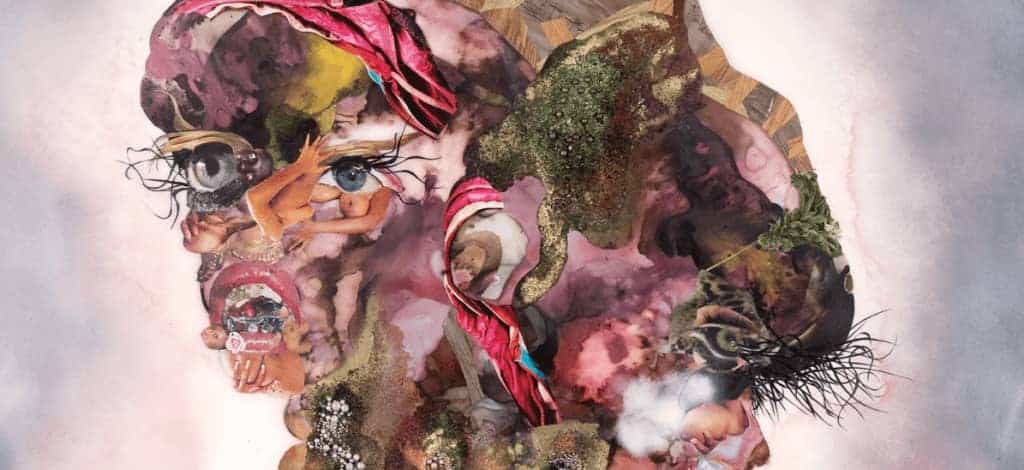
Collage art FAQ
What is collage art?
Collage art is a technique within art production that uses different types and forms of assemblage to form a composition within the artwork thereby creating a new whole from the constituent parts. Collage artists usually include elements like newspapers, paint, clothing and other kinds of objects.
Who are the most famous collage artists?
The most renowned collage artists are Georges Braque, Pablo Picasso, Kurt Schwitters, Hannah Höch, Joseph Cornell, Henri Matisse, Robert Rauschenberg, Wangechi Mutu
Where did collage art originate?
The technique and term originated hundreds of years ago but made its breakthrough in the early 20th century as an art technique in itself when artists like Georges Braque and Pablo Picasso used it as a key part of their early Cubist practice.
Relevant sources to learn more:
A Walk Through Spirits of the Soil with Raquel van Haver – Artland
If you liked our selection of collage artists, see also our overview of contemporary artists reinventing silhouette art: Silhouettes: Art Between Light and Shadow – Artland











